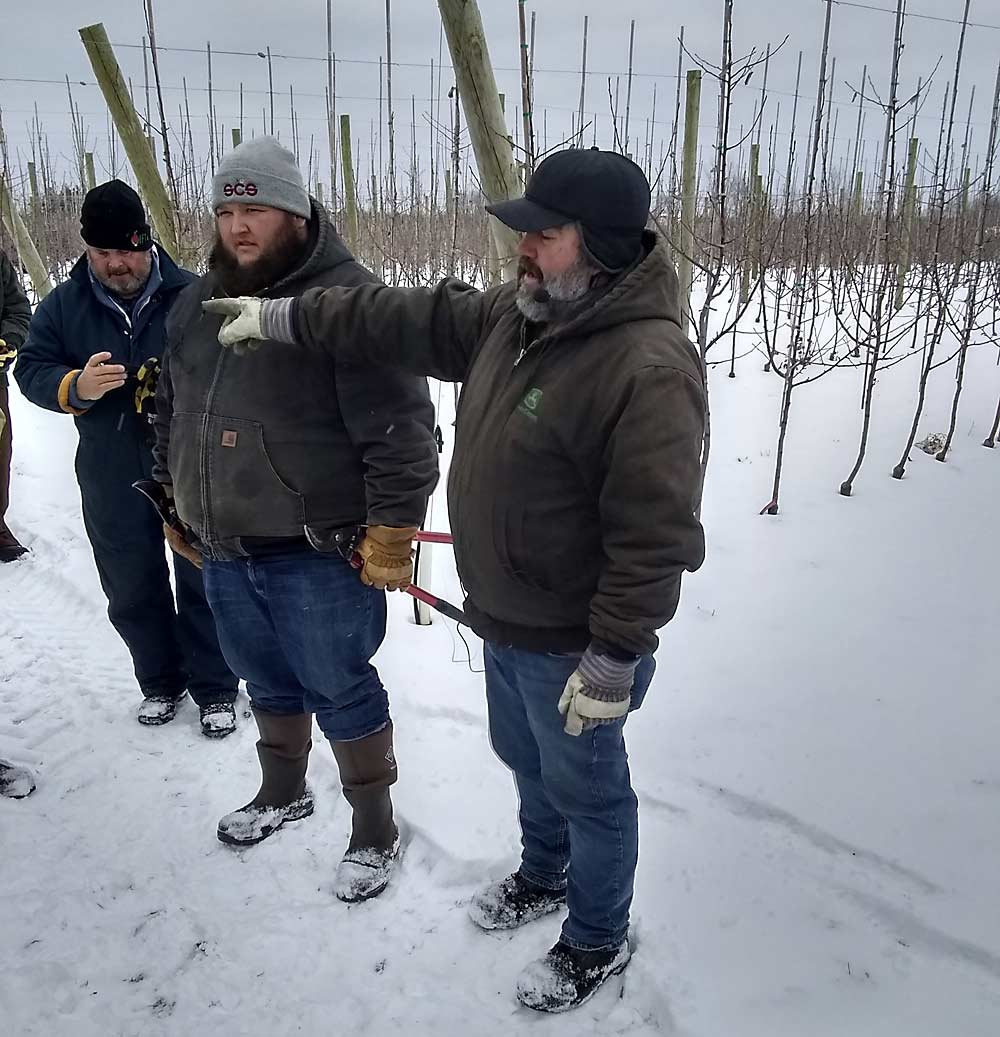
Day two of the International Fruit Tree Association’s Grand Rapids conference started at Michigan State University’s Clarksville Research Center.
MSU Extension researchers showed the bus tour visitors a multileader training trial for apples. The trial started in 2014, when the Michigan Tree Fruit Commission funded a project to evaluate multileader training systems. Bench-grafted trees were planted at the center in 2015. 2020 was their second cropping year, according to the researchers.
The multileader trial includes five varieties on four systems: super spindle, two-leader, three-leader and tall spindle. All of the systems were planted with the same stems-per-acre density except the tall spindle, which was planted at half the density. The trees were 8 feet tall by the end of the third growing season; they were allowed to fruit in the fourth season, 2018.
All of the systems were productive and yielded high-quality fruit. Super spindle produced the greatest number of bins per acre, followed by two-leader, tall spindle and three-leader. The three-leader system produced the highest yield per tree, followed by two-leader, tall spindle and super spindle, according to the researchers.
The most productive variety in 2019 was Gala, at 27.5 bins per acre, followed by Fuji (20.4), Jonagold (15.1), McIntosh (11.8) and Honeycrisp (6). The high-vigor varieties filled space rapidly and settled into fruiting quickly. Low-vigor Honeycrisp lagged behind other varieties in terms of filling space. McIntosh was overthinned and did not perform as well in 2019 as it did in 2018.
Two-leader had the greatest number of apples per tree for Gala, Fuji, McIntosh and Honeycrisp. Super spindle had the lowest number of apples per tree but the highest yield per acre. Tall spindle had the highest-producing stem, according to the researchers.
In the afternoon, the IFTA tour visited Windy Ridge Orchards on the Fruit Ridge north of Grand Rapids. Owned by Chuck and Kyle Rasch, the farm grows 220 acres of apples and 5 acres of peaches. Chuck, who’s been growing peaches since 1985, planted a V system in the early 2000s. He wanted to work with the peach tree’s tendency for upright growth. In 2015, he planted a block of UFO (upright fruiting offshoot) peaches, after seeing a trial at the Clarksville center. MSU Professor Greg Lang said a UFO system for peaches is very rare. Rasch’s uprights were spaced 12 to 15 inches apart. Lang suggested increasing the spacing to about 30 inches, to avoid shade.
At Thome Orchards, Harold, Steve and Mitch Thome (representing the fourth, fifth and sixth generations of ownership, respectively) introduced themselves in front of a block of Aztec Fuji and Royal Red Honeycrisp (10-foot by 2-foot spacing on Malling 9337 rootstock). Now in the fourth leaf, the Fujis yielded 250 bushels per acre last fall, but the Honeycrisps haven’t produced yet. They need time to fill more space, Steve said.
Thome Orchards also grows Gala, Cameo, Jonagold, Red Delicious, McIntosh, Golden Delicious, Paula Red, Ida Red, Rome and Jonathan on M.9337, M.9, Nic.29, and Geneva 11 rootstocks. Its current plantings are at spacings of 10- feet by 2-feet and 11-feet by 3-feet.
—by Matt Milkovich
Related:
—IFTA’s first day has precise focus
—IFTA Day 3: Precise crop management
—IFTA Day 4: Innovation in the even colder






Leave A Comment